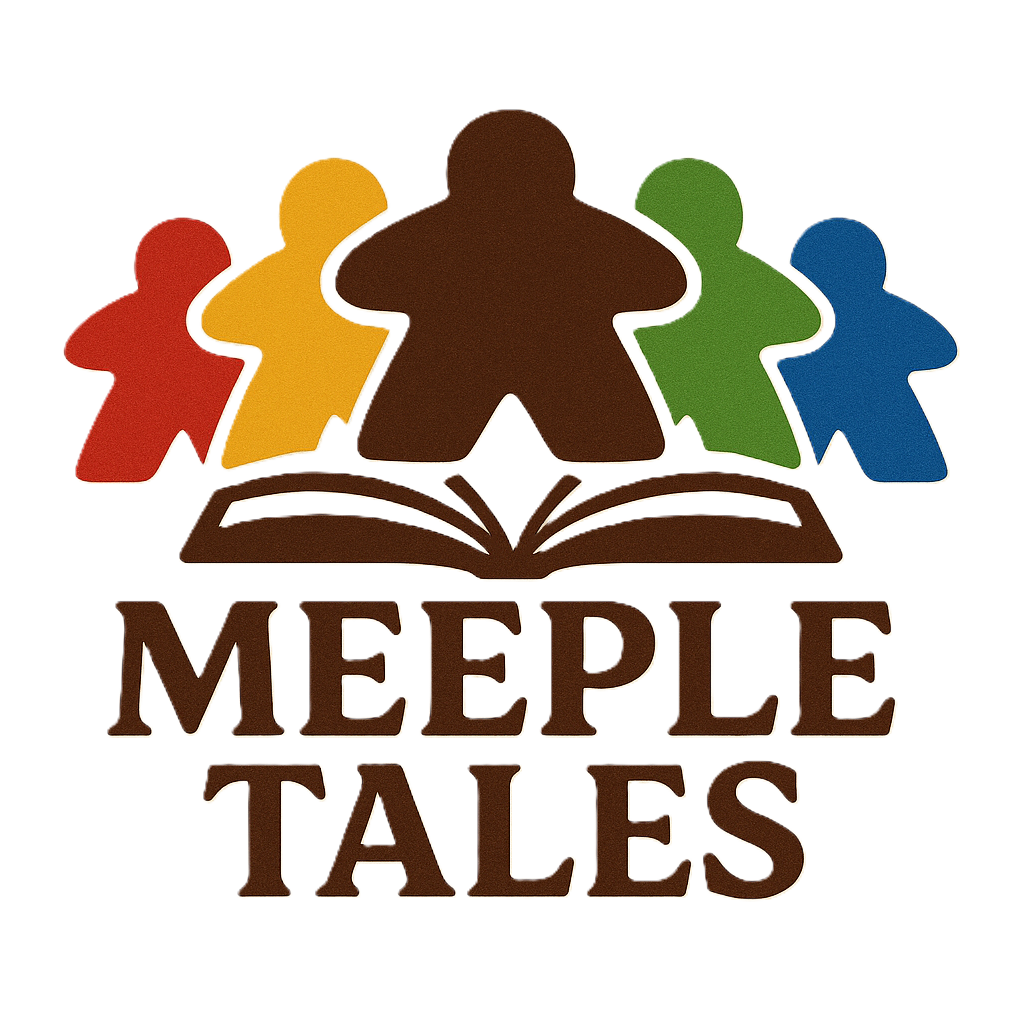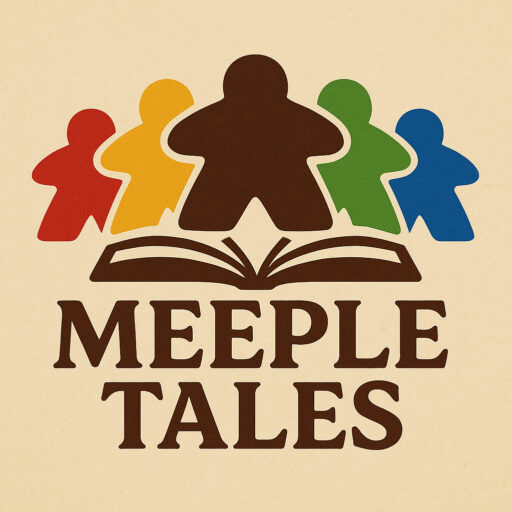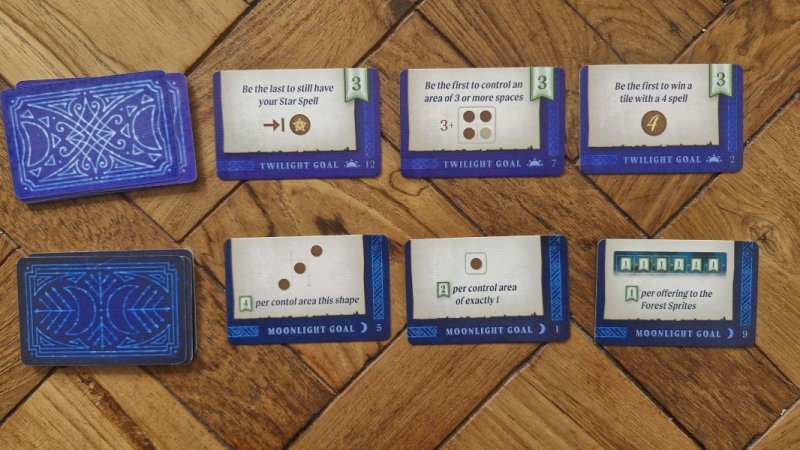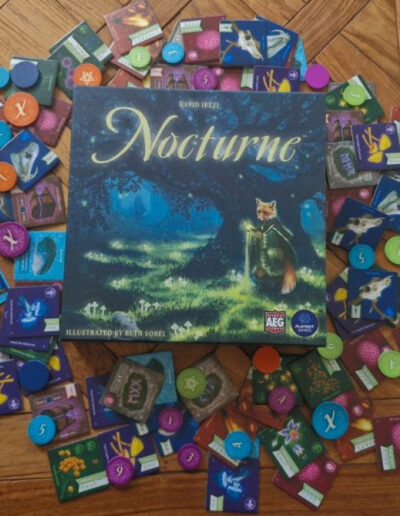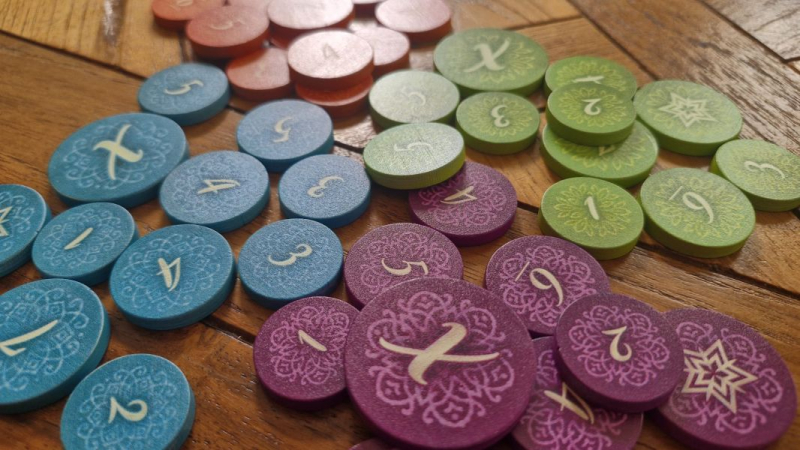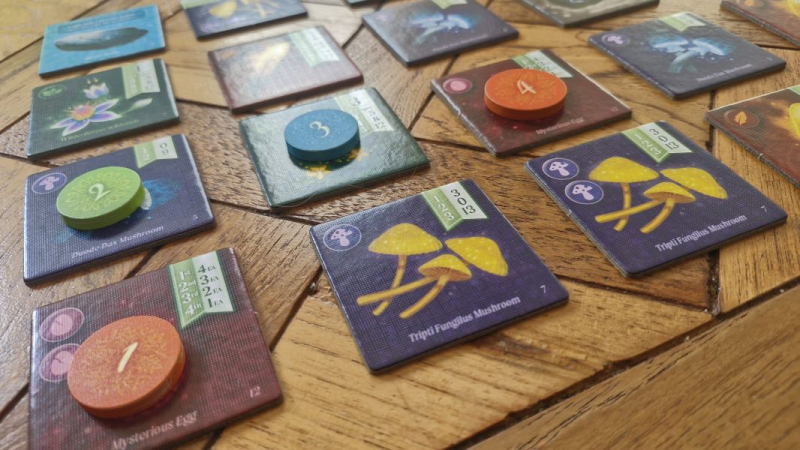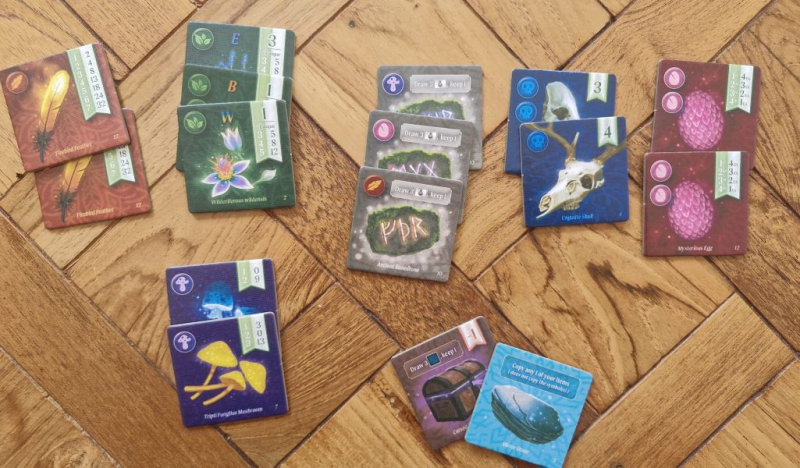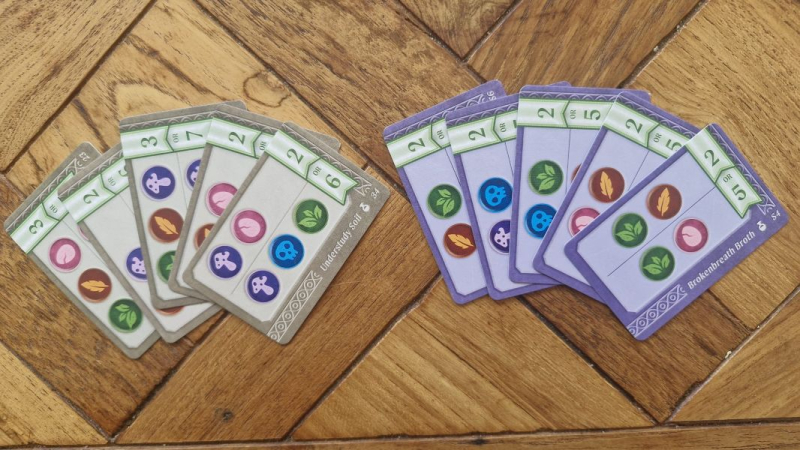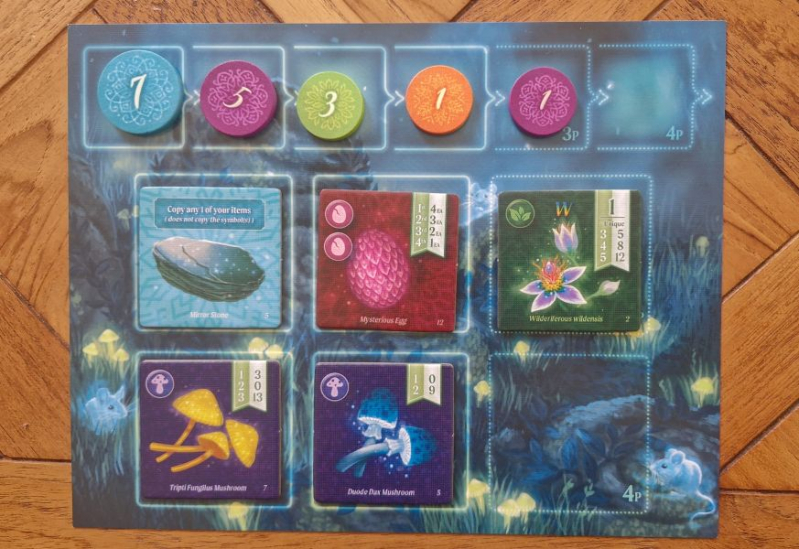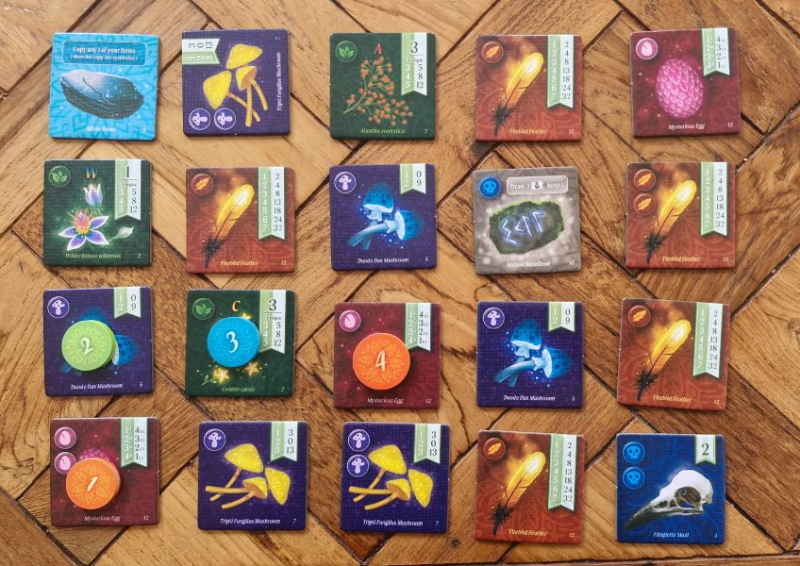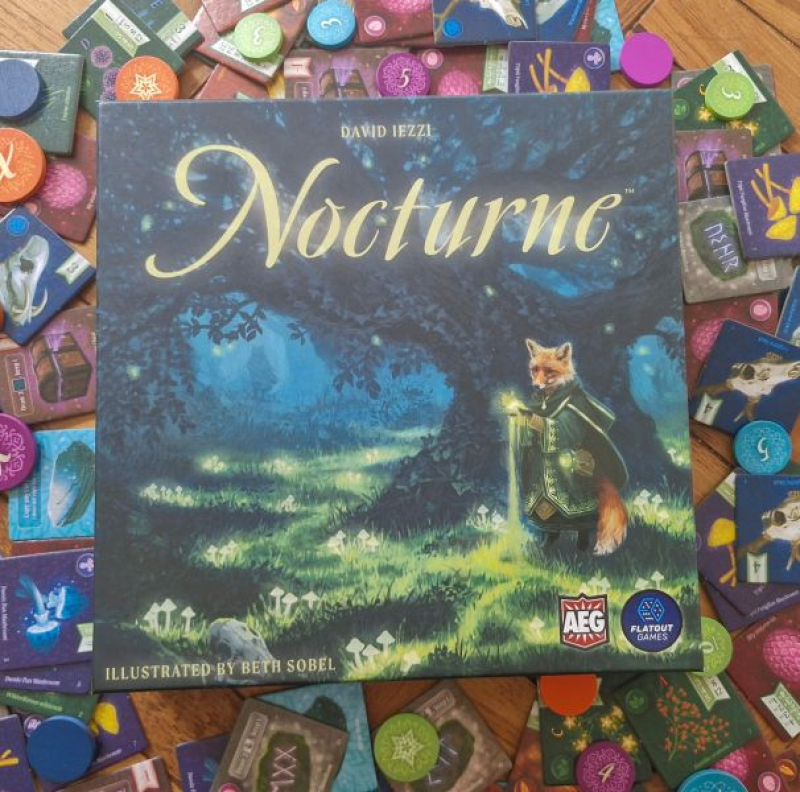Aantal spelers: 1-4
Speelduur: 30-45 minuten
Leeftijd: Vanaf 8 jaar
Auteur: David Iezzi
Uitgever: White Goblin Games
Jaar: 2024
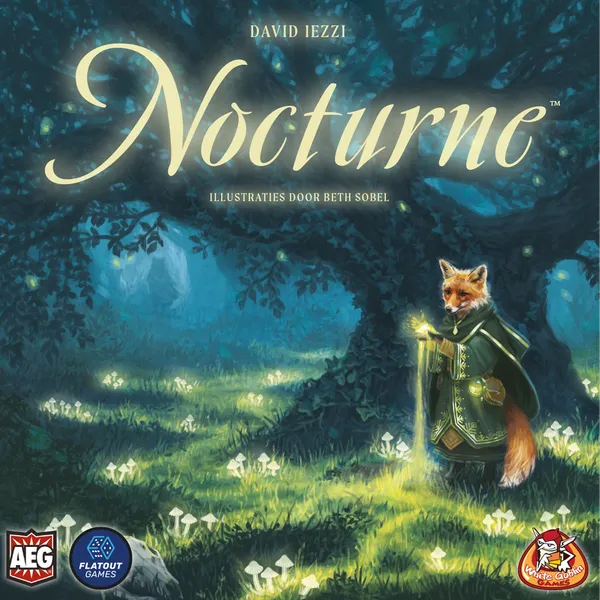

Ja hoor, ze heeft het weer voor elkaar. Beth Sobel. Nog voor ik ook maar iets van het spel wist wilde ik het hebben. Gewoon als kunstwerkje. Perfect passend naast haar andere kunstwerkjes, waarvan er al zoveel in de kast staan. Vraag haar een mystieke dierenwereld te creëren en zij is daar. En ik dan dus ook, want ik hou er van. Meestal zorgt dat voor een nog betere spelbeleving en zijn haar illustraties complementair aan het spelmechanisme.
Ik zou maar wat graag wonen in de werelden die zij creëert. Nocturne heeft naast Beth het CoLab ontwikkelteam gemeen met Calico, Cascadia en Verdant. Je zou denken dat dit een garantie is voor kwaliteit en je er blind van uit kan gaan, dat wanneer deze drie spellen tot jouw collectie behoren (wat bij mij het geval is), Nocturne het rijtje compleet zou maken. Helaas is dat wat mij betreft juist niet het geval. En hoewel je steeds hoopt dat spellen beter worden en makers zich overtreffen bij een volgend spel, vrees ik dat dat bij deze set-collector waarbij je gaat bieden voor mij die vlieger niet helemaal op gaat.
Begrijp me niet verkeerd, je zult zien dat ik gewoon afsluit met een voldoende. Dat heeft vooral te maken met het goed doordachte unieke spelmechaniek, waar echt wel een goed plan achter zit. Maar het gekozen thema en het spelmechaniek zijn dit keer niet persee complementair aan elkaar waardoor ik niet meegesleept worden in een wereld of verhaal. Ik verwonder me niet over de pracht, het draagt dit keer niet persee bij aan een betere spelbeleving (sommige illustraties steken zelfs wat luguber af). Dat ligt echt aan het teveel ontbreken van inhoudelijke verbinding. Zie dit niet direct als negatieve review, maar wel als disclaimer voor het verder lezen. Zie het als verwachtingsmanagement. Verwacht als Calico, Cascadia en Verdant-fan geen nieuw pareltje te ontdekken. Het mechaniek is erg specifiek en is niet ieders ding en had net zo goed een space-thema kunnen hebben of iets anders willekeurigs. Dit spel moet je echt op de game play benaderen en niet op de fysieke aantrekkingskracht. Ik zal het spel dus ook vrij droog uitleggen, omdat alle inhoudelijke termen die aan het mechaniek zijn gehangen om de boel op te leuken, de originele handleiding alleen maar onnodig ingewikkeld maken.
Hoe wordt het spel gespeeld?
In Nocturne ga je in twee rondes proberen om uit een grid de meest waardevolle tegels te halen door er op te bieden. Er zijn verschillende sets te verzamelen die allemaal hun eigen scoringsvoorwaardes hebben. Zo zijn er skulls die per stuk scoren, veren waarvan je gewoon zo veel mogelijk wilt hebben, paddenstoelen zijn er in verschillende sets, van de kruiden verzamel je juist graag juist verschillende eenlingen en van de mysterieuze eieren wordt je helemaal blij. Die scoren lekker als je de meeste hebt ten op zichten van anderen. Deze tegels zijn daarnaast allemaal voorzien van een symbooltjes, die je ook wilt verzamelen. In het spel kun je namelijk zogeheten concotion-kaartjes verzamelen die punten opleveren als je aan het einde van het spel de symbolen op de kaartjes hebt weten te verzamelen. Daarnaast werk je beide rondes aan gezamenlijke doelen, waarbij de doelen in de eerste ronde enkel scoren voor de eerste persoon die het doel bereikt en in de tweede ronde zijn het eindtellingskaarten die voor iedereen gescoord worden, mits je natuurlijk aan de voorwaarden voldoet. Tot nu toe klinkt het vrij eenvoudig, nietwaar?
Dan nu het bieden. Alle spelers krijgen bij aanvang fiches met oplopende biedwaardes. De speler die aan de beurt is legt een fiche ter bieding op één van de tegels die klaarliggen in een grid. (Grootte afhankelijk van het aantal spelers). Hier zitten wat haken en ogen aan, want dit mag niet zomaar een random tegel zijn, dit is onlosmakelijk verbonden aan de afloop van de bieding ervoor. In de basis moet de nieuwe bieding aangrenzend zijn aan de zojuist verworven tegel, en wordt deze gestart door de speler die de vorige bieding heeft gewonnen. Aangezien na een bieding de tegel wordt weggehaald, ontstaan er gaten en in het grid en is dit dus niet meer altijd mogelijk. In dat geval wordt de volgende speler de nieuwe bieder.
Wanneer er geboden is mag er om en om overboden worden. Dit doe je niet op de tegel waarop zojuist geboden is, maar op een tegel aangrenzend aan deze tegel met het huidige hoogste bod. Kan of wil je niet overbieden dan pas je. Als iedereen heeft gepast, krijgt de eigenaar van het hoogste bod die tegel. De tegel wordt uit het grid gehaald en mag de bieder toevoegen aan diens collectie. Het fiche blijft in het grid liggen en doet deze ronde niet meer mee.
De andere spelers mogen hun zojuist geplaatste fiches terghalen. Deze komen weer beschikbaar voor een volgende bieding, tenzij ze besluiten hun fiche op het “Forest Sprite” bord te leggen. Dit is een soort markt, waaruit aan het van de ronde tegels gekozen kunnen worden. Mits je fiche dan nog op het bord ligt, aangezien hogere fiches voorrang hebben op lagere en er maar gelimiteerd plek is. Wanneer de te reserveren plekken op het bord op zijn en een hoger fiche biedt zich na een beurt aan, dan wordt het laagste fiche gewoon weer uit de markt gekickt en grijp je aan het einde van de ronde mis. De speler van wie dit fiche is, mag deze wel weer terug op handen nemen en in een volgende beurt gebruiken om te bieden.
Toch zul je je hoge fiches ook bij je willen houden. Want wanneer je aan het einde van de eerste ronde (wanneer het volledige grid is leeg gespeeld) nog fiches over hebt. Krijg je voor de tweede ronde mogelijk extra fiches. Deze fiches worden onder alle spelers verdeeld, beginnend bij de spelers met het hoogste fiche, afwerkend naar beneden. Overigens zijn deze zowel een vloek als een zegen, omdat je hiermee niet naar de markt kan en ze ook niet mee tellen in de doelen van de tweede ronde. Deze doelen bestaan uit patronen die in het grid ontstaan. Bijvoorbeeld: Punten voor fiches in de hoek. Of punten voor fiches die niet aan een van je andere fiches grenzen. Iets wat een tweede ronde dus extra uitdagend maakt. Je jaagt dan dus niet alleen op specifieke tegels én symbolen, maar óók nog op een specifieke plek. Door de extra fiches kan je vaker bieden, maar ze kunnen voor je doelen ook zeker in de weg liggen.
Na de twee ronde tel je de punten van je sets bij elkaar op. Aangevuld met punten voor behaalde kaartjes, de ronde doelen, punten voor overgebleven fiches en eventueel voor je karakter. Dit is een unieke eigenschap die je als advanced player kan krijgen bij de start. Wanneer je diens unieke kracht niet hebt hoeven gebruiken in het spel, levert deze ook nog punten op. De speler met de meeste punten wint.
Wat vind ik er van?
Mijn geneuzel over de vormgeving en missende connectie daarmee, aside: het mechanisme van dit spel zit goed in elkaar. Hoewel het erg simpel lijkt, krijgt het karakter en moeilijkheid door de kaartjes, de markt en de plaatsingsvoorwaardes van een nieuwe bieding. Het feit dat je niet zomaar op alles kan bieden is een bemoeilijkende factor en tevens iets waar mee je kan spelen. Wanneer je een tegel niet wilt en je ook vermoed dat je nog wel overboden zal worden is het slim om wel mee te bieden om zo bijvoorbeeld te voorkomen dat een speler een bepaalde tegel wel of niet krijgt. Je fiche krijg je tenslotte toch wel terug. Je kunt de biedingen letterlijk een kant van het bord op sturen en er bijvoorbeeld voor gaan zorgen dat jij door de plaatsing op het bord sowieso de laatste bieder bent omdat er geen aangrenzende tegels meer zijn, zodra het spel bij jou uitkomt. Zo zijn er allemaal componenten waarmee je kan spelen en manipuleren, waardoor het mechanisme het niveau van een standaard set-collector meer dan overstijgt. Helemaal omdat je tegelijkertijd ook nog op andere paarden wedt én je tegenstander zal proberen hetzelfde te doen. De symbooltjes die je spaart voor je kaartjes staan niet noodzakelijkerwijs op de kaartjes die je nodig hebt om je sets compleet te maken. Dat vraagt met name in de tweede ronde om afgewogen keuzes en slim in te zetten, omdat de tegels waarschijnlijk óók niet op de plek liggen waarmee je de gezamenlijke doelen leuk kan scoren. Soms zie je de perfecte kaart dan dus in de markt liggen. Maar wil je er zeker van zijn dat je die straks mag kopen, dan moet je zorgen dat je hoogste fiche op het bord belandt. Dat is vervolgens weer ingewikkeld omdat de kans groot is dat die niet overblijft, maar je de bieding laat winnen en je hem dus kwijt bent. Door al deze keuzes voelt het spel niet louter als een bied of veiling spelletje, waar ik normaliter best op af kan knappen. Hoewel het mijn favoriete genre niet zal worden laat Nocturne wel zien dat bied-spellen het party-niveau ver kunnen ontstijgen én dat bieden meer kan zijn dan alleen de hoogste zijn en elkaar aftroeven. Het heeft wel degelijk strategie. Vanwege het verrassende mechanisme zal het hier in huis echt nog wel vaker op tafel komen. Maar wel altijd denkend: wat doen al die prachtige illustraties van Beth in hemelsnaam in dit spel?

Nocturne
Players: 1-4
Time: 30-45 minuten
Age: Vanaf 8 jaar
Author: David Iezzi
Publisher: White Goblin Games
Year: 2024


Yes, she’s done it again. Beth Sobel. Even before I knew anything about the game, I wanted it. Just as a work of art. It would fit perfectly alongside her other works of art, of which there are already so many in my collection. Ask her to create a mystical animal world and she’s there. And so am I, because I love it. Usually, this enhances the gaming experience and her illustrations complement the game mechanics.
I would love to live in the worlds she creates. Nocturne shares the CoLab development team with Calico, Cascadia, and Verdant. You would think that this is a guarantee of quality and that you can blindly assume that if these three games are part of your collection (which is the case for me), Nocturne would complete the set. Unfortunately, that is not the case for me. And although you always hope that games will improve and that creators will surpass themselves with their next game, I fear that this is not entirely true for this set collector’s item, where you bid for the pieces.
Don’t get me wrong, you’ll see that I’m still giving it a passing grade. That’s mainly because of the well-thought-out, unique game mechanics, which are based on a really good plan. But this time, the chosen theme and the game mechanics aren’t necessarily complementary, so I don’t get swept away into a world or story. I’m not surprised by the beauty, as this time it doesn’t necessarily contribute to a better gaming experience (some illustrations even seem a bit grim). That’s really due to the lack of connection between the content. Don’t read this as a negative review, but rather as a disclaimer before you read on. Think of it as expectation management. If you’re a fan of Calico, Cascadia, and Verdant, don’t expect to discover a new gem. The mechanics are very specific and not everyone’s cup of tea, and it could just as easily have had a space theme or something else random. You really have to approach this game for its gameplay and not for its physical appeal. I will therefore explain the game in a fairly dry manner, because all the content-related terms that have been attached to the mechanics to make things more fun only serve to make the original manual unnecessarily complicated.
How is the game played?
In Nocturne, you try to get the most valuable tiles from a grid in two rounds by bidding on them. There are different sets to collect, each with their own scoring conditions. For example, there are skulls that score per piece, feathers that you simply want to collect as many as possible, mushrooms that come in different sets, herbs that you want to collect as different individuals, and mysterious eggs that make you very happy. These score well if you have the most compared to others. These tiles also all have symbols that you want to collect. In the game, you can collect so-called concoction cards that earn you points if you have collected the symbols on the cards at the end of the game. In addition, you work on joint goals in both rounds, with the goals in the first round only scoring for the first person to reach the goal and in the second round being final score cards that are scored for everyone, provided you meet the conditions, of course. So far, it sounds pretty simple, right?
Now for the bidding. At the start, all players receive tokens with ascending bid values. The player whose turn it is places a token on one of the tiles laid out in a grid (the size of which depends on the number of players). There are a few snags here, because this cannot be just any random tile; it is inextricably linked to the outcome of the previous bid. Basically, the new bid must be adjacent to the tile just acquired, and is started by the player who won the previous bid. Since the tile is removed after a bid, gaps appear in the grid and this is therefore not always possible. In that case, the next player becomes the new bidder.
When bids have been made, players may take turns to outbid each other. You won’t do this on the tile that has just been bid on, but on a tile adjacent to the tile with the current highest bid. If you cannot or do not want to outbid, you pass. When everyone has passed, the owner of the highest bid receives that tile. The tile is removed from the grid and may be added to the bidder’s collection. The token remains in the grid and is no longer part of this round.
The other players may retrieve the tokens they just placed. These become available for the next bidding round, unless they decide to place their token on the “Forest Sprite” board. This is a kind of market from which tiles can be selected at the end of the round, provided your token is still on the board, as higher tokens take precedence over lower ones and there is limited space. When the spots on the board are full and a higher token is offered after a turn, the lowest token is simply kicked out of the market and you miss out at the end of the round. The player who owns this token may take it back and use it to bid in the next turn.
However, you will want to keep your high tokens. Because if you have tokens left at the end of the first round (when the entire grid has been played), you may receive extra tokens for the second round. These tokens are distributed among all players, starting with the players with the highest tokens and working down. These tokens are both a blessing and a curse, because you can’t go to the market with them and they do not count towards the goals of the second round. These goals consist of patterns that emerge in the grid. For example: points for chips in the corner. Or points for chips that do not border any of your other chips. This makes the second round extra challenging. So you’re not only hunting for specific tiles and symbols, but also for a specific location. The extra tokens allow you to bid more often, but they can also get in the way of your goals.
After the two rounds, you add up the points from your sets. This is supplemented with points for cards obtained, the round goals, points for remaining tokens, and possibly for your character. This is a unique feature that you can get as an advanced player at the start. If you don’t have to use your unique power in the game, it also earns you points. The player with the most points wins.
What do I think?
My ramblings about the design and the lack of connection with it aside, the mechanics of this game are well thought out. Although it seems very simple, the cards, the market, and the placement conditions for a new bid give it character and difficulty.
The fact that you can’t just bid on everything is a complicating factor and also something you can play with. If you don’t want a tile and you suspect that you will be outbid, it is smart to bid anyway to prevent another player from getting a certain tile. After all, you will get your token back. You can literally send the bids to one side of the board and, for example, to ensure that you are the last bidder anyway because there are no more adjacent tiles when the game comes back to you. There are all kinds of components you can play with and manipulate, which makes the mechanism far more sophisticated than a standard set collector game. Especially since you are also betting on other horses at the same time and your opponent will try to do the same. The symbols you save for your cards are not necessarily on the cards you need to complete your sets. This requires careful choices and smart moves, especially in the second round, because the tiles are probably not in the right place for you to score points for your common goals. Sometimes you will see the perfect card in the market. But if you want to be sure you can buy it later, you have to make sure your highest token ends up on the board. That’s complicated because there’s a good chance it won’t be left over, but you’ll win it and lose it. All these choices make it so the game doesn’t feel like a mere bidding or auction game, which I normally don’t enjoy. Although it won’t become my favorite genre, Nocturne does show that bidding games can rise above the party level and that bidding can be more than just being the highest and outbidding each other. It definitely has strategy. Because of the surprising mechanism, it will definitely be played more often in our house. But always with the thought: what on earth are all those beautiful illustrations by Beth doing in this game?
